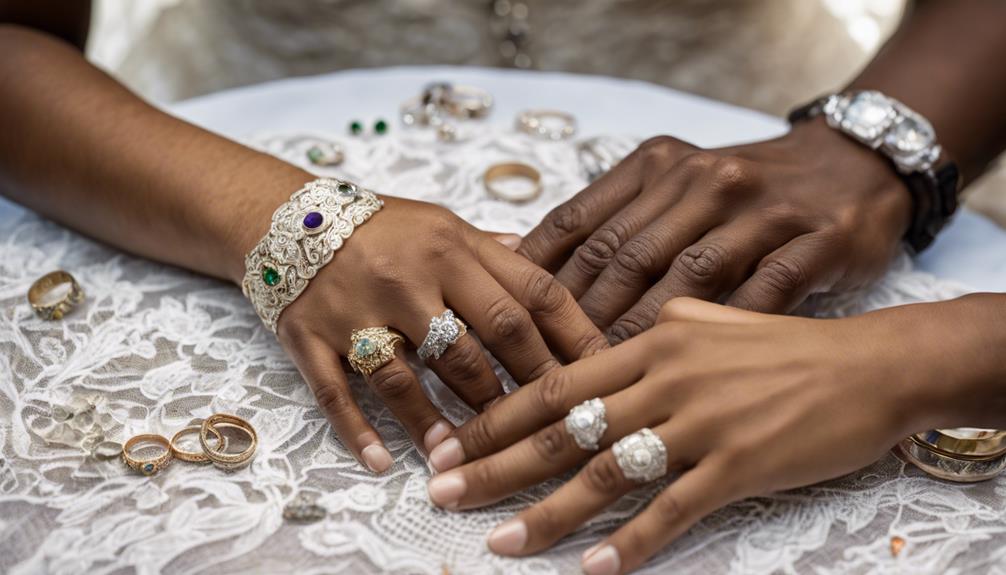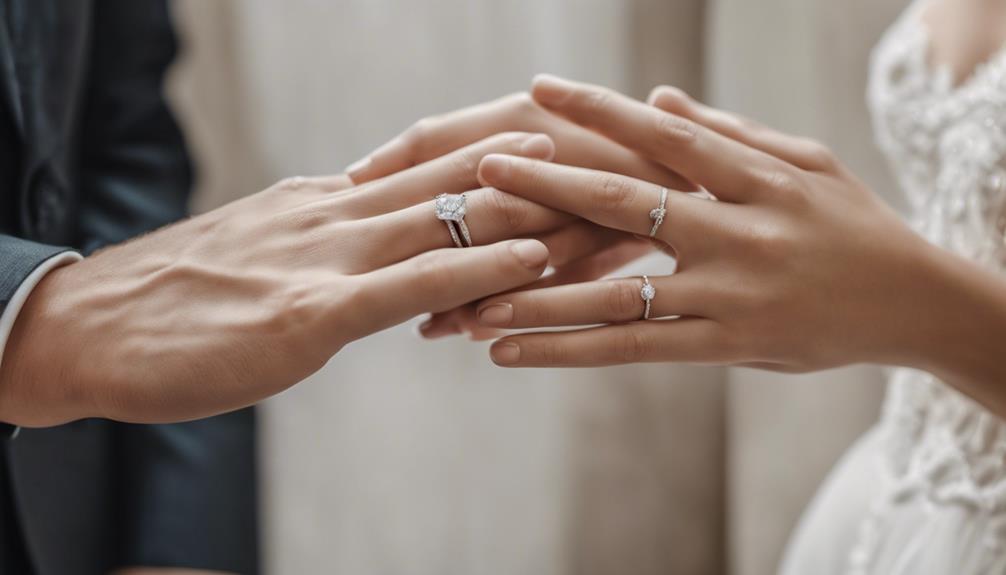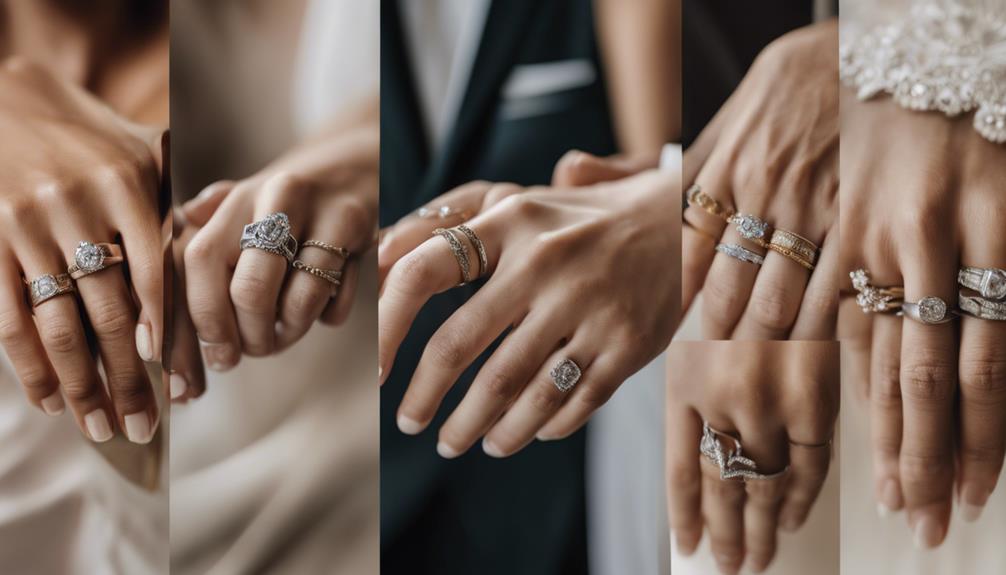You’ve got traditions to contemplate when it comes to wearing your rings. Typically, the engagement ring goes on the fourth finger of your left hand, especially in Western cultures, where the “vena amoris” symbolizes a direct connection to the heart. However, in countries like Russia, Germany, and India, it’s common to wear engagement rings on the right hand. During the wedding ceremony, some opt to move their engagement ring to the right hand to make way for the wedding band. This choice often reflects both cultural traditions and personal preferences. There’s more to discover regarding symbolism and modern trends.
Traditional Ring Hand Choices

When it comes to traditional ring hand choices, you’ll find intriguing variations across different cultures. In many Western cultures, the engagement ring finger is typically the fourth finger of the left hand. This tradition stems from the belief in the Vena Amoris, a vein thought to run directly from this finger to the heart, symbolizing love.
However, not every culture embraces this practice. For instance, in Russia, Germany, and India, the engagement ring often finds its place on the right hand, reflecting unique cultural traditions and beliefs.
When you shift from engagement to marriage, the placement of rings changes for some. During wedding ceremonies, you might move your engagement ring to the right hand to make room for the wedding band on the left hand. This switch highlights the significance of the wedding ring‘s placement, symbolizing love and commitment.
Interestingly, in cultures like Sweden and Chile, men also participate in wearing engagement rings, often choosing the right hand until the wedding. These practices underline the diverse ways people celebrate love and commitment, showing that the choice between left or right hand tells a story deeply rooted in cultural traditions and personal beliefs.
Cultural Differences in Ring Wear
Cultural differences in ring wear often reveal fascinating insights into the diverse ways people express love and commitment. In many Western cultures, engagement rings typically adorn the left hand’s ring finger, a tradition linked to the “vena amoris,” believed to connect directly to the heart. During the wedding, the wedding rings are placed on the same finger, symbolizing a seamless shift from engagement to marriage.
However, in countries like Russia, Germany, and India, engagement rings are worn on the right hand, showcasing how cultural differences influence ring placement.
In some cultures, like Sweden and Chile, men also wear engagement rings on their right hand until marriage, highlighting variations in gender practices regarding rings. This practice underlines the diverse approaches to expressing commitment worldwide.
Meanwhile, in China, the exchange of engagement rings often takes a backseat to exchanging money and goods, emphasizing different cultural interpretations of commitment.
Some traditions involve switching the engagement ring to the right hand during the wedding ceremony, marking the shift from engagement to marriage. These varied customs reflect how deeply personal and culturally influenced the choice of ring hand can be, illustrating the rich tapestry of love’s expression across different societies.
Symbolism Behind Each Hand

Imagine slipping an engagement ring onto the fourth finger of your left hand, a gesture steeped in tradition and symbolism. This act traces back to the ancient belief in the Vena Amoris, a vein thought to connect directly to the heart.
The left hand, often associated with love and permanence, becomes the symbolic bearer of your commitment. This choice of hand underscores a romantic notion that your engagement ring is physically linked to your deepest emotions.
In contrast, wedding rings in some cultures find their place on the right hand, carrying a different type of symbolism. The right hand, seen as a symbol of practicality and resilience, highlights the steadfast commitment required in marriage. This tradition is prevalent in many Eastern European cultures, where the right hand signifies the practical journey of married life.
Here’s a quick rundown to help you grasp the symbolism behind each hand:
- Left hand: Represents love and permanence, linking the engagement ring to the heart.
- Right hand: Symbolizes practicality and resilience, often chosen for wedding rings.
- Cultural variations: Highlight diverse expressions of love and commitment across societies.
These practices reveal how deeply cultural beliefs influence the symbolism of engagement and wedding rings.
Modern Trends and Preferences
In recent years, there’s been a noticeable shift in how people choose to wear their engagement and wedding rings, with personal style and cultural influences playing significant roles.
Modern trends have embraced wearing engagement rings on the right hand, reflecting a blend of personal preference and evolving cultural norms. This change highlights a move away from traditional practices, allowing individuals to express their unique identities and beliefs.
Couples are now creatively stacking their wedding bands and engagement rings, making these symbols of love more personalized. This trend offers flexibility in design and style, letting you mix and match to suit your taste.
Additionally, non-traditional engagement ring styles, like colored gemstones and unique settings, are gaining popularity. They offer a fresh twist to the classic diamond solitaire, appealing to those who want something different.
Interestingly, some people choose to wear their engagement ring and wedding band on separate hands, prioritizing comfort and personal flair over convention.
Another emerging trend is men wearing engagement rings, a powerful statement reflecting shifting gender norms and a push towards inclusivity.
These modern trends show that, ultimately, your ring-wearing choices should align with what feels right for you.
Personalizing Ring Placement

When it comes to personalizing ring placement, there’s no one-size-fits-all approach, and that’s what makes it special. Your choice of where to wear your engagement rings and wedding rings can reflect your personal preferences, cultural variations, or a mix of both.
In Western cultures, a common practice is to wear engagement rings on the fourth finger of the left hand, followed by the wedding ring during the ceremony. However, in some Eastern European and South American cultures, it’s customary to wear these rings on the right hand, aligning with local traditions.
Personal preferences can lead to unique ring placement choices. Some individuals opt to wear the wedding band first, placing the engagement ring on top to symbolize the completion of their journey to marriage. Others might switch hands for comfort or practicality, finding that both rings feel best on the right hand.
Here are some ideas to contemplate when personalizing your ring placement:
- Cultural Significance: Choose a hand or finger based on your cultural background or beliefs.
- Comfort: Think about switching hands or fingers for better comfort.
- Symbolism: Stack your rings to represent your personal journey and commitment.
Conclusion
Ultimately, the hand you choose for your engagement and wedding rings is a deeply personal decision. While traditions and cultural differences offer insight into historical practices, they shouldn’t dictate your choice. Embrace the symbolism that resonates with you, whether it’s the connection to the heart or the public declaration of love. Modern trends allow flexibility, so personalize your ring placement to reflect your unique relationship and values, ensuring it truly symbolizes your commitment and joy.



